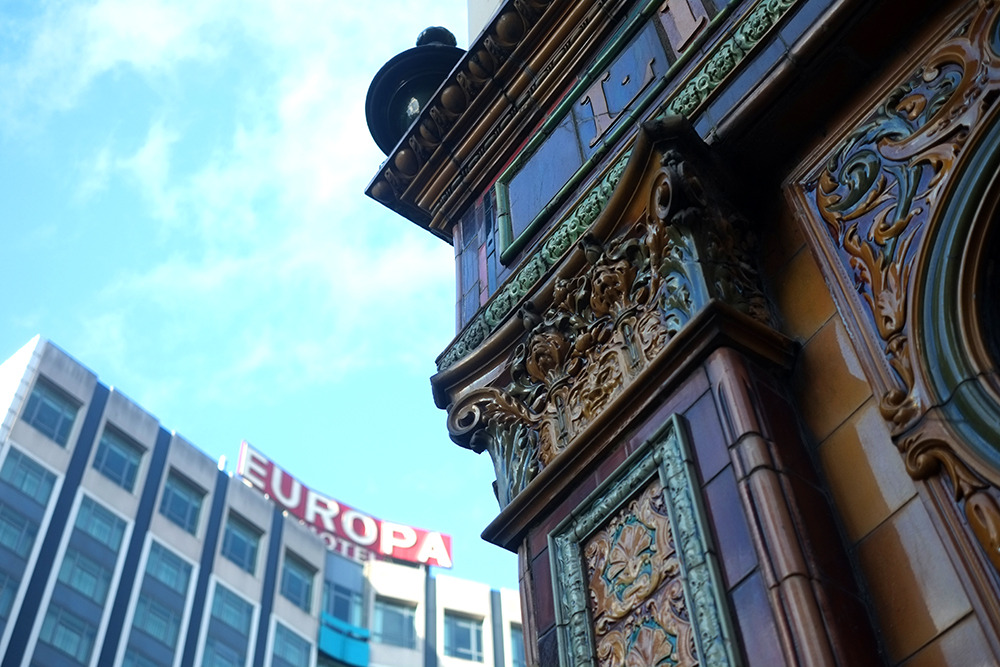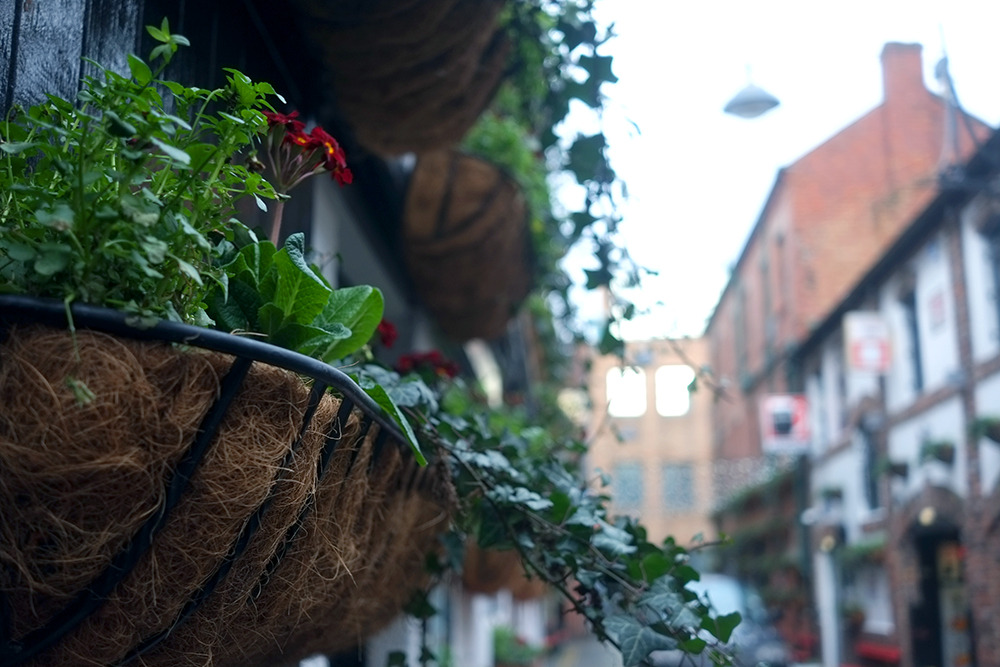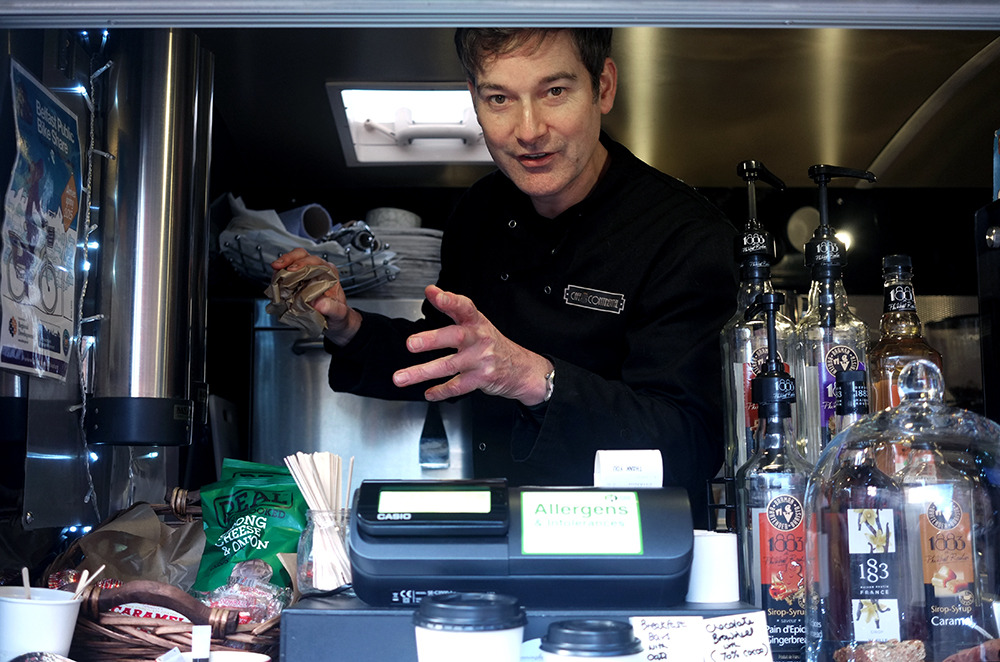Of Garden Paths and Urban Routes

As I sit and work beside a window overlooking my garden, I observe a small barn cat crossing the lawn toward a distant cluster of trees. Both this particular cat and a few of the others make this journey several times a day. And the fascinating thing about it is, they don’t hop across the grass. Neither do they slink through the shrubbery. Rather amazingly, they follow the garden path. The dedicated garden path - a gently curving narrow dirt tract - is not the quickest or the most direct route across the lawn. The cats are not required to use it; indeed no one would expect it of them. And yet they insist on walking along the path, in an elegantly unhurried sort of trot - as if drawn to this more civilised method of moving from A to B.

Pondering this, I think back to my first visit to Belfast earlier in the week. A mere 2 hours away by train, Belfast is by no means inaccessible and I had meant to visit it much sooner - only somehow never had cause to. But finally, a cause arose. And on a cold sunny winter morning I emerged from the depths of Great Victoria Station to find myself in an unmistakably urban landscape of tall buildings and wide avenues.
 With a couple of hours to kill before my appointment, I set off to wander around on foot. The center of Belfast has a vaguely Bostonian look to it, with red brick and white stone and a certain quaintness to it despite the occasional swathe of post-modern glass reflecting clouds and steeples and our own mortality and attractive shopping centers.
With a couple of hours to kill before my appointment, I set off to wander around on foot. The center of Belfast has a vaguely Bostonian look to it, with red brick and white stone and a certain quaintness to it despite the occasional swathe of post-modern glass reflecting clouds and steeples and our own mortality and attractive shopping centers. 
Unlike the center of Boston though, the streets were almost uncannily clean and quiet, and relatively light in both motorised and pedestrian traffic.

As for bicycles, it was as if some emergency ban had been placed on the city in the course of which all trace of them had been removed. Not only did I see no cyclists as I stood and tried to get my bearings at a central intersection, but I didn't even see any bicycles locked to any racks or railings. Alongside a mural depicting a V.I. Lenin-like fellow and an old city map, inscribed with the ennui-inspiring message "Today's plan is already yesterday's - the streets that were there are gone," I spied what was almost certainly a bike lane. It was as free of cyclists and the main lane beside it was free of cars.
The city center appeared to have a fairly logical layout, and I decided to follow the big main road and see where it would lead. Certainly not to bicycles, it would seem. But perhaps somewhere interesting still.

But no sooner had I crossed the main intersection than my plans changed. Having spotted a narrow alley, something compelled me to see where it would lead, instead of continuing along the main road. And that was how I discovered the labyrinthine system of alleyways, pedestrian passages and courtyards hidden within the wide city blocks.

Here, there were cobblestones and benches and walls lined with geranium planters. There were artsy murals. There were pubs and galleries nestled beside half-demolished buildings. There were also quite a few pedestrians.

Here also I finally saw the first hint of bicycles.

Followed rapidly by another.

And another.
Seeing this Pashley Princess and several other bikes behind glass made me suspect that Belfast was perhaps teeming with bicycles after all - only most of them arrived in the city early and were then quickly whisked inside office buildings.

With minor exceptions.

Pausing my walk to buy a coffee, I spotted a poster inside the vintage Citroen - turned vending truck announcing the imminent arrival of a Belfast bikeshare system. I asked about it, and learned that it was coming in spring. A station is to be installed right beside the truck, in the pedestrian courtyard. There must be cyclists here if they are doing this, I thought. Perhaps today was just a very cold day and not a good example of local cycling culture.

Then again, when the bike share system arrives perhaps it will be like another garden path - offering an alternative, and inexplicably appealing means of travel merely through the power of suggestion.
I will have to visit Belfast again soon and see.


O the bricks they will bleed and the rain it will weep,
ReplyDeleteAnd the damp Lagan fog lull the city to sleep;
It's to hell with the future and live on the past:
May the Lord in His mercy be kind to Belfast.
In my experience Belfast isn't particularly bike-friendly and in the 60s it suffered a similar fate to many other cities with urban motorways being built into and through the centre and tram (streetcar) tracks being taken up to make more room for cars on the streets.
There was also Belfast's own "flight to the suburbs" with people leaving the city centre to escape the cramped two up two down rows of terraces and the troubles. And the burbs are very car dependent.
There are about 280k people in the City of Belfast, with about the same again in the greater Belfast area, so it isn't huge and while you have stumbled across some interesting spots, I'm not sure there is the Belfast equivalent of someone like Hackney in London or Williamsburg in Brooklyn that have gentrified and developed a bicycle culture.
There are some examples of Belfast bike infrastructure shown (ironically…) in this blog:
https://nigreenways.wordpress.com/2013/09/15/belfast-cycling-study-tour/
Ha! Thanks for that link.
DeleteI am still waiting eagerly for the Limavady - Derry rail trail NI Greenways has promised : )
DeleteIt's not amazing animals follow paths. It's just life.
ReplyDeleteAll cities are laid out like this - boulevards vs. alleys.
Nice pictures though.
“All cities are laid out like this - boulevards vs. alleys.”
DeleteActually, I don’t think most cities are laid out like that, unless you mean that all cities have streets of varying widths. In my visualization of Belfast based on Velouria’s description, it has superblocks formed by boulevards and avenues, and then a mix of smaller streets, lanes and alleys within those larger blocks. That arrangement is quite distinct from the high-density western cities I’m familiar with--the spaghetti plate of winding London streets, say, or the avenues and side streets of Manhattan’s street grid. It’s also, of course, quite different from the street plans employed by newer low-density American cities (with their arterial highways and cul-de-sac subdivisions in between). These differences have a huge impact on how a bicyclist experiences a city.
Oddly, the superblocks from Velouria’s description to me most resemble Taipei of all places. (Except that in Taipei the boulevards and avenues are full of traffic.) There the interior lanes and alleys often lack sidewalks altogether, but the traffic is much slower. Consequently, commuting cyclists would use them as much as possible when I lived there. The problem was those narrow streets usually didn’t offer the most direct route, and they didn’t necessarily line up with the lanes and alleys of the next superblock. In the years since the subway system has been completed there, they’ve widened some of the avenues’ sidewalks and given the outer portion of them to bicycles (somewhat like Tokyo). It seems as if Belfast has accomplished something similar with bike lanes.
There is quite a lot of similarity between the centre of Belfast and Melbourne in that, as you say, there are blocks formed by major streets then a network of lanes within the blocks. Both cities were built in the Victorian era.
DeleteMelbourne is quite a good model for Belfast to follow in that over the last 20 years, the Melbourne lanes have developed their own distinct culture with many independent arts-related businesses, cafes and restaurants setting up there and this has given the city centre a lot more life in the evening.
I mean there are always major thoroughfares and lesser-travelled arterials, full stop. The rest is language.
DeleteHa, the rickety doors and half brick wall is immediately adjacent to my office, which was, in a previous life, a warehouse for a bicycle importer.
ReplyDeleteNice town! What camera and raw converter do you use by the way?
ReplyDeleteWith bicycle photos I shoot straight to jpg. When I do shoot raw, I use RPP.
DeleteCameras: Fuji X-Pro 1 and Nikon D600.
I think you should change this from a bicycle blog to a photo diary blog. The photos are now the strength and bicycles secondary. As one who rides daily in all kinds of weather and landscapes and immensely enjoys bicycles, I find theres a point where discussion of frames and geometry and components and accessories becomes boring. I'm not a performance rider. But beautifully composed photos of places available to ones who move about via bicycles is endlessly interesting. A reminder to keep looking. Thanks.
ReplyDeleteI have a photo diary blog. You can visit it here.
DeleteYou know this started out as a cat and knitting blog, right? It's eventually going to become a sailing and animal husbandry blog.
DeleteSpindizzy
Ahem. Aviation, not sailing.
DeleteI meant when after you're done with Airplanes...
DeleteSpindizzy
p.s. I'm not speaking of the illustrative photos.
ReplyDeleteMy cats have paths that they created and follow them, intents in the grass. As for Belfast, always great to find the cool spots, and I can't help but think of The Fall....
ReplyDeleteIf series 3 comes out, I hear they plan to have Gillian Anderson riding a black Pashley.
DeleteI don't know the the Fuji, but I shoot mostly with the D610, sometimes the D700 and on holidays/bike rides I use the D90 for it's light weight (and its cheapness!). And they're all capable of producing excellent images - if I shoot raw. My girlfriend and I did a bike ride around the island of Bornholm last summer where I used the d90 mostly in jpeg, but when I got home there was a vast difference between the jpegs and the few raws. I use Capture One 8 pro and I just love it! The workflow is fast, and I can make local corrections (much like layers in photoshop) to exposure, white balance, colors, saturation, etc. This means that I for instance can correct the white balance and exposure of the sky, and bring out the shadows in backlit buildings (like your picture of "Europa Hotel"), without affecting the rest of the image It's sort of like HDR, but much more effective. It's the single one thing that does the most difference in quality and appearance of my images. So for me it's always raw :-)
ReplyDeleteI used a D90 until I wore it out, then upgraded to the D600 a couple of years ago. The Fuji X-Pro1 is a compact, mirrorless camera that in some ways outperforms DSLRs. It is also much easier to cycle and hike with.
DeleteI do not do much post-processing. But I like the fine control of RPP when I do.
I cycle in Belfast every day, but rarely around the area you describe, Great Victoria Street and the centre. I suspect most cyclists going there lock their bikes and walk around the shops, particularly in the little alleys. And it was a cold day. There are odd variations in the pattern of cycling in Belfast. You see far more in the south, Ormeau Road than in the West and North. This isn't a class thing. In straitened times the bike is often just the most economical form of transport for people who would love to be able to afford the bus fares or a car. And a lot of people use the safer and more scenic route into the city along the river. You shoudl come again and I'll show you bikes and take you for a tootle along the tow path.
ReplyDeleteI shall come with my own bicycle next time and take you up on that!
DeleteLet's face it: If being in the city centre is not enough and you need to be taken somewhere special to see citizens cycling, then Belfast is not yet a cycling city.
DeleteI don't think the locals would disagree with you. Malachi himself describes some of this in his book. But cities can change in a surprisingly short time. And my first impression is, that Belfast does have all the ingredients for cycling to thrive.
Delete"Belfast has a vaguely Bostonian look to it"
ReplyDeleteI think you mean that Boston has a Belfastian look to it.
As a city, Boston is actually the older of the two. Much of Boston's architecture is older as well.
DeleteAre you sure? Boston was founded in 1630, Belfast prior to 665 discounting Bronze Age settlements in the area.
DeleteBelfast was classified as a village on 1610 maps and its "town and castle(!)" were subject of a grant by the English King James in 1612. Wikipedia even says "In 1613 the town was constituted a corporation, of a sovereign, twelve burgesses and a commonalty, with the privilege of sending two representatives to parliament." Giddy heights!
Admittedly, Belfast as a modern city really only emerged in the 18th century, but still...
(My grand-great-grandmother left Belfast in the early 1830s, married a boy from Dublin (all pre-partition of course) and immediately set sail for Canada.)
Of course, looking at existing architecture today, Boston's is older. The last conflict there was in the 1790s whereas Belfast's troubles were much more recent. It's all about what survives.
DeleteWell, if we’re talking pre-historic then Boston's timeline would start with Native American settlements and not with Puritan colonies.
DeleteBut I was specifically referring to what you describe as the emergence of the cities. Officially Boston was given city status in 1822. Belfast in 1888. And as far as I understand, the core development of Boston as a port/industrial/educational center preceded Belfast’s by an even wider margin.
Anyhow... In my post I noted that today’s Belfast resembles today’s Boston visually - that is, in architecture and layout. The original comment above then suggested that Boston must be thought of as resembling Belfast and not the other way around, implying that Belfast's current look precedes Boston’s. I believe this to be incorrect, in the sense that much of the architecture and infrastructure we see in Boston today predates Belfast’s, that's all. And while the Troubles in Belfast were certainly more recent than any conflict Boston has gone through (assuming you do not count the 2013 marathon bombing), I do not think any buildings destroyed in the Troubles would alter this pattern. Neither would the buildings destroyed during the WWII Belfast Blitz for that matter...
PS: Speaking of buildings destroyed during the Troubles - the Hotel Europa in the 2nd photo is known as “the most bombed hotel in Europe.”
Yes, untangling all the caveats in all of our comments... I agree that much of what we see today in Boston predates Belfast. I like both cities very much.
DeleteBelfast's evolution in the 1800s was fundamentally shaped by the industrial revolution so I think there are a lot of similarities in architecture and infrastructure between Belfast and other "northern industrial towns" * in Great Britain.
DeleteLife Belfast, the evolution of cities like Leeds, Newcastle and Glasgow were also heavily based upon industries like shipbuilding or textiles so there are a lot of similarities.
* while he may be an acquired taste, the song of this name by Billy Bragg is worth a listen
This reminded me of Haifa, Israel. I grew up in Chicago with its near uniform grid of streets and avenues. Pre-Internet and Google, when I was 21 I rented a car and tried to find my way across Haifa with just a road map that was more urban legend than map. Streets started, stopped, twisted and turned with some natural ancient logic that didn't allow for the existence, or even concept of automobiles. The closest thing I've found in the states is Philadelphia, never having been to Boston myself.
ReplyDeleteThat was beautiful. I loved the pictures that went with it and wish my city was as stunning.
ReplyDeleteSome excellent photography!
ReplyDeleteHad to delurk to thank you for the grin inspired by what must surely be a typo:
ReplyDelete"...announcing the impeding arrival of a Belfast bikeshare system."
Ha, thanks. Typos are the best.
DeleteBeautiful photos! I enjoy reading about -- and seeing pictures of -- bicycles as a way of life.
ReplyDeletehttp://vimeo.com/82369449
ReplyDeleteNext time you are up you should check out the Belfast Bicycle Workshops, above is a short video clip of it.
It has a great stone special (made in belfast) 1950's track bike on the wall, a couple of the guys that are around the shop pretty often also have mercians (including my Vinctoire Audax). It's a great hub for vintage and transport cycling, amazing building too. It's just round the corner from Queen's University.
https://www.facebook.com/BelfastBicycleWorkshop?fref=ts